BUSM 4504 - HRM: Conflict Resolution Practices for HR Professionals
VerifiedAdded on 2023/06/03
|14
|3581
|341
Report
AI Summary
This report delves into the critical conflict resolution practices that HR professionals must understand to effectively manage workplace disputes. It emphasizes the importance of listening, teamwork, and self-awareness in resolving conflicts. The report outlines a grievance process, including informal discussions, preliminary investigations, and full internal investigations, with options for external resolution if necessary. It also examines various conflict management approaches such as competing, accommodating, avoiding, collaborating, and compromising, along with eight key steps in managing conflict, including discussing the situation, gathering and giving information, problem-solving, generating solutions, agreeing on solutions, implementation, and follow-up. Furthermore, it covers useful negotiation strategies like establishing shared goals, separating people from the problem, and focusing on interests. The report highlights the importance of HR's role in fostering a fair and productive work environment by addressing conflict constructively.
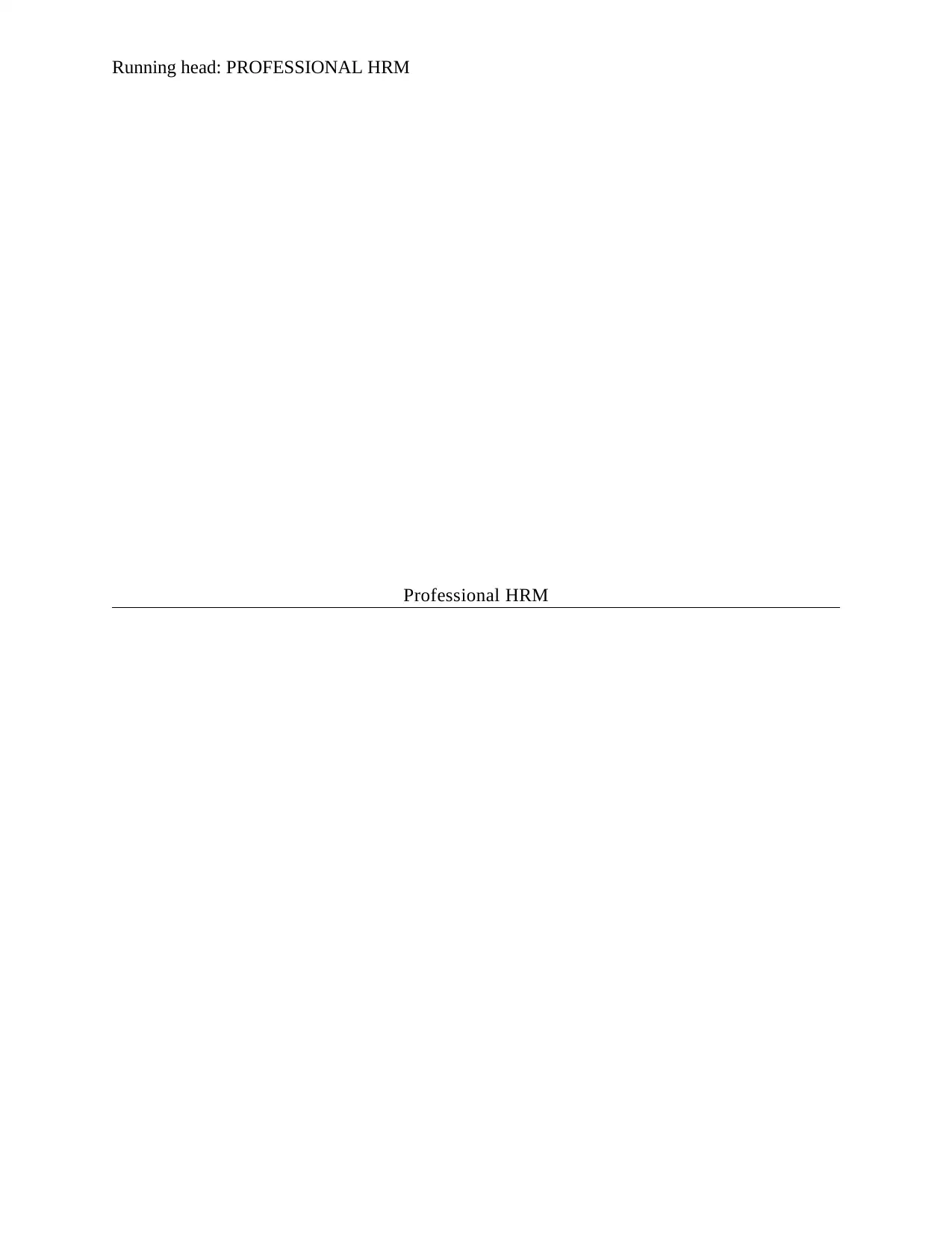
Running head: PROFESSIONAL HRM
Professional HRM
Professional HRM
Paraphrase This Document
Need a fresh take? Get an instant paraphrase of this document with our AI Paraphraser

PROFESSIONAL HRM 2
Table of Contents
Introduction.................................................................................................................................................3
Key conflict resolution practices HR professionals need to understand......................................................3
Conclusion.................................................................................................................................................11
References.................................................................................................................................................12
Table of Contents
Introduction.................................................................................................................................................3
Key conflict resolution practices HR professionals need to understand......................................................3
Conclusion.................................................................................................................................................11
References.................................................................................................................................................12
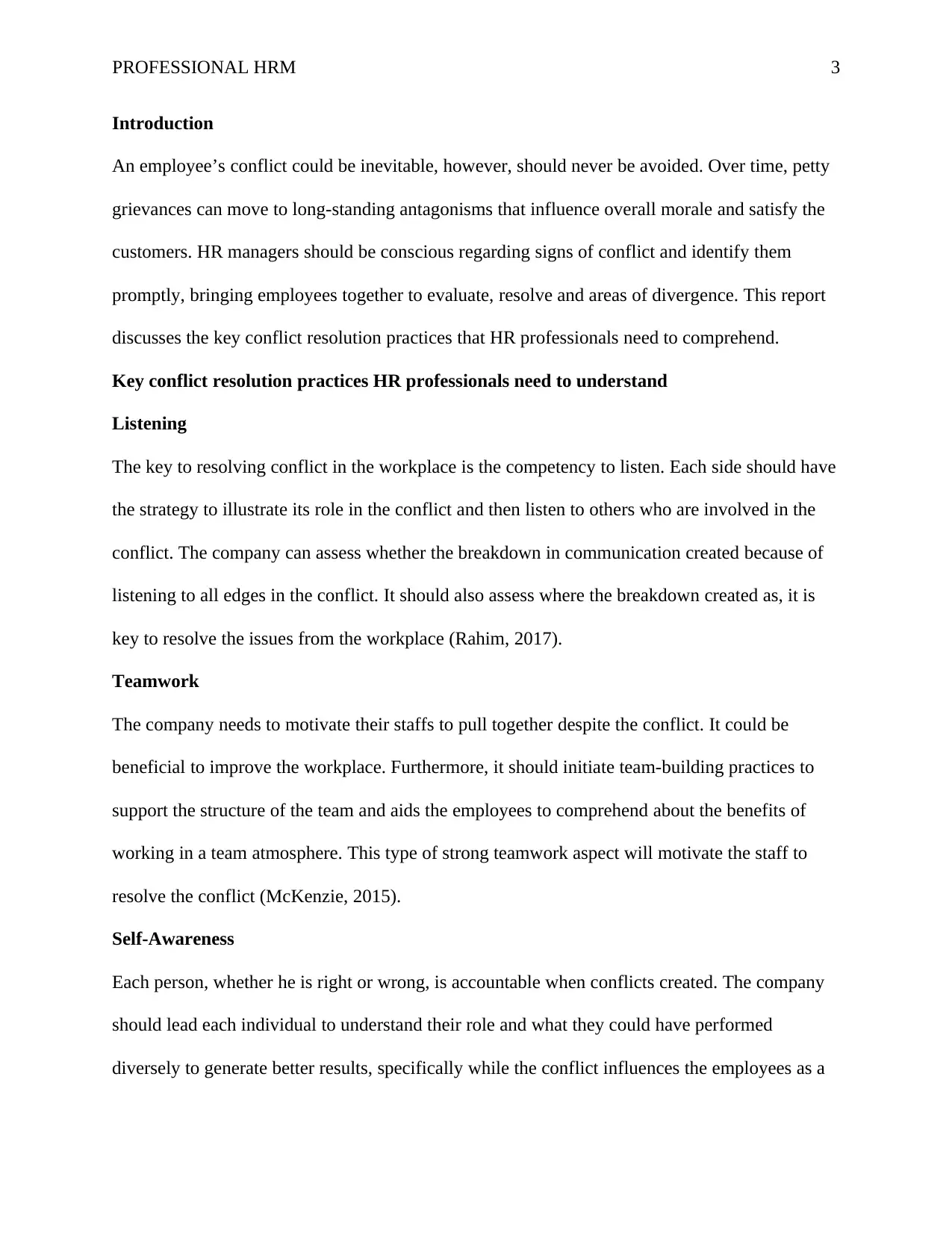
PROFESSIONAL HRM 3
Introduction
An employee’s conflict could be inevitable, however, should never be avoided. Over time, petty
grievances can move to long-standing antagonisms that influence overall morale and satisfy the
customers. HR managers should be conscious regarding signs of conflict and identify them
promptly, bringing employees together to evaluate, resolve and areas of divergence. This report
discusses the key conflict resolution practices that HR professionals need to comprehend.
Key conflict resolution practices HR professionals need to understand
Listening
The key to resolving conflict in the workplace is the competency to listen. Each side should have
the strategy to illustrate its role in the conflict and then listen to others who are involved in the
conflict. The company can assess whether the breakdown in communication created because of
listening to all edges in the conflict. It should also assess where the breakdown created as, it is
key to resolve the issues from the workplace (Rahim, 2017).
Teamwork
The company needs to motivate their staffs to pull together despite the conflict. It could be
beneficial to improve the workplace. Furthermore, it should initiate team-building practices to
support the structure of the team and aids the employees to comprehend about the benefits of
working in a team atmosphere. This type of strong teamwork aspect will motivate the staff to
resolve the conflict (McKenzie, 2015).
Self-Awareness
Each person, whether he is right or wrong, is accountable when conflicts created. The company
should lead each individual to understand their role and what they could have performed
diversely to generate better results, specifically while the conflict influences the employees as a
Introduction
An employee’s conflict could be inevitable, however, should never be avoided. Over time, petty
grievances can move to long-standing antagonisms that influence overall morale and satisfy the
customers. HR managers should be conscious regarding signs of conflict and identify them
promptly, bringing employees together to evaluate, resolve and areas of divergence. This report
discusses the key conflict resolution practices that HR professionals need to comprehend.
Key conflict resolution practices HR professionals need to understand
Listening
The key to resolving conflict in the workplace is the competency to listen. Each side should have
the strategy to illustrate its role in the conflict and then listen to others who are involved in the
conflict. The company can assess whether the breakdown in communication created because of
listening to all edges in the conflict. It should also assess where the breakdown created as, it is
key to resolve the issues from the workplace (Rahim, 2017).
Teamwork
The company needs to motivate their staffs to pull together despite the conflict. It could be
beneficial to improve the workplace. Furthermore, it should initiate team-building practices to
support the structure of the team and aids the employees to comprehend about the benefits of
working in a team atmosphere. This type of strong teamwork aspect will motivate the staff to
resolve the conflict (McKenzie, 2015).
Self-Awareness
Each person, whether he is right or wrong, is accountable when conflicts created. The company
should lead each individual to understand their role and what they could have performed
diversely to generate better results, specifically while the conflict influences the employees as a
⊘ This is a preview!⊘
Do you want full access?
Subscribe today to unlock all pages.

Trusted by 1+ million students worldwide
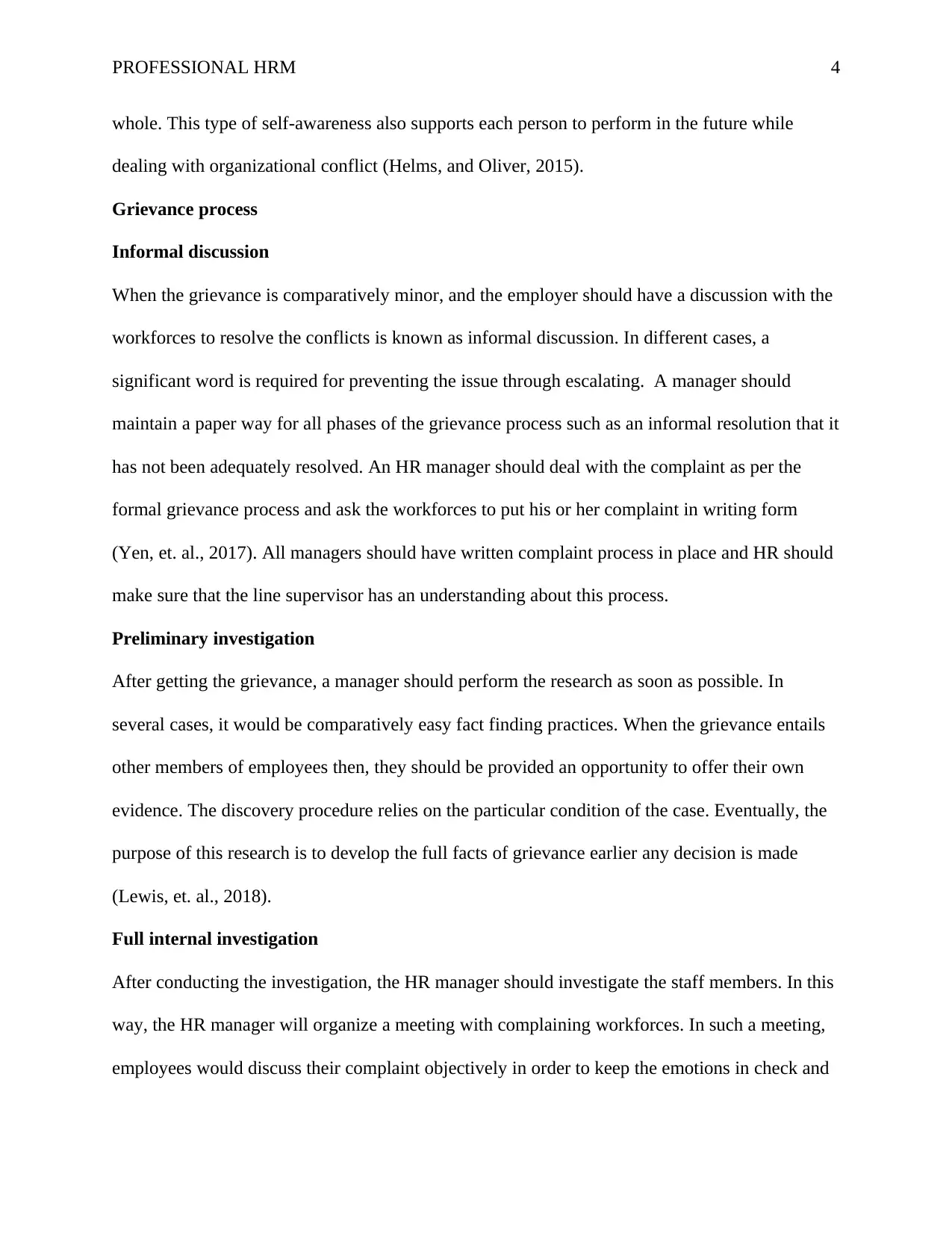
PROFESSIONAL HRM 4
whole. This type of self-awareness also supports each person to perform in the future while
dealing with organizational conflict (Helms, and Oliver, 2015).
Grievance process
Informal discussion
When the grievance is comparatively minor, and the employer should have a discussion with the
workforces to resolve the conflicts is known as informal discussion. In different cases, a
significant word is required for preventing the issue through escalating. A manager should
maintain a paper way for all phases of the grievance process such as an informal resolution that it
has not been adequately resolved. An HR manager should deal with the complaint as per the
formal grievance process and ask the workforces to put his or her complaint in writing form
(Yen, et. al., 2017). All managers should have written complaint process in place and HR should
make sure that the line supervisor has an understanding about this process.
Preliminary investigation
After getting the grievance, a manager should perform the research as soon as possible. In
several cases, it would be comparatively easy fact finding practices. When the grievance entails
other members of employees then, they should be provided an opportunity to offer their own
evidence. The discovery procedure relies on the particular condition of the case. Eventually, the
purpose of this research is to develop the full facts of grievance earlier any decision is made
(Lewis, et. al., 2018).
Full internal investigation
After conducting the investigation, the HR manager should investigate the staff members. In this
way, the HR manager will organize a meeting with complaining workforces. In such a meeting,
employees would discuss their complaint objectively in order to keep the emotions in check and
whole. This type of self-awareness also supports each person to perform in the future while
dealing with organizational conflict (Helms, and Oliver, 2015).
Grievance process
Informal discussion
When the grievance is comparatively minor, and the employer should have a discussion with the
workforces to resolve the conflicts is known as informal discussion. In different cases, a
significant word is required for preventing the issue through escalating. A manager should
maintain a paper way for all phases of the grievance process such as an informal resolution that it
has not been adequately resolved. An HR manager should deal with the complaint as per the
formal grievance process and ask the workforces to put his or her complaint in writing form
(Yen, et. al., 2017). All managers should have written complaint process in place and HR should
make sure that the line supervisor has an understanding about this process.
Preliminary investigation
After getting the grievance, a manager should perform the research as soon as possible. In
several cases, it would be comparatively easy fact finding practices. When the grievance entails
other members of employees then, they should be provided an opportunity to offer their own
evidence. The discovery procedure relies on the particular condition of the case. Eventually, the
purpose of this research is to develop the full facts of grievance earlier any decision is made
(Lewis, et. al., 2018).
Full internal investigation
After conducting the investigation, the HR manager should investigate the staff members. In this
way, the HR manager will organize a meeting with complaining workforces. In such a meeting,
employees would discuss their complaint objectively in order to keep the emotions in check and
Paraphrase This Document
Need a fresh take? Get an instant paraphrase of this document with our AI Paraphraser
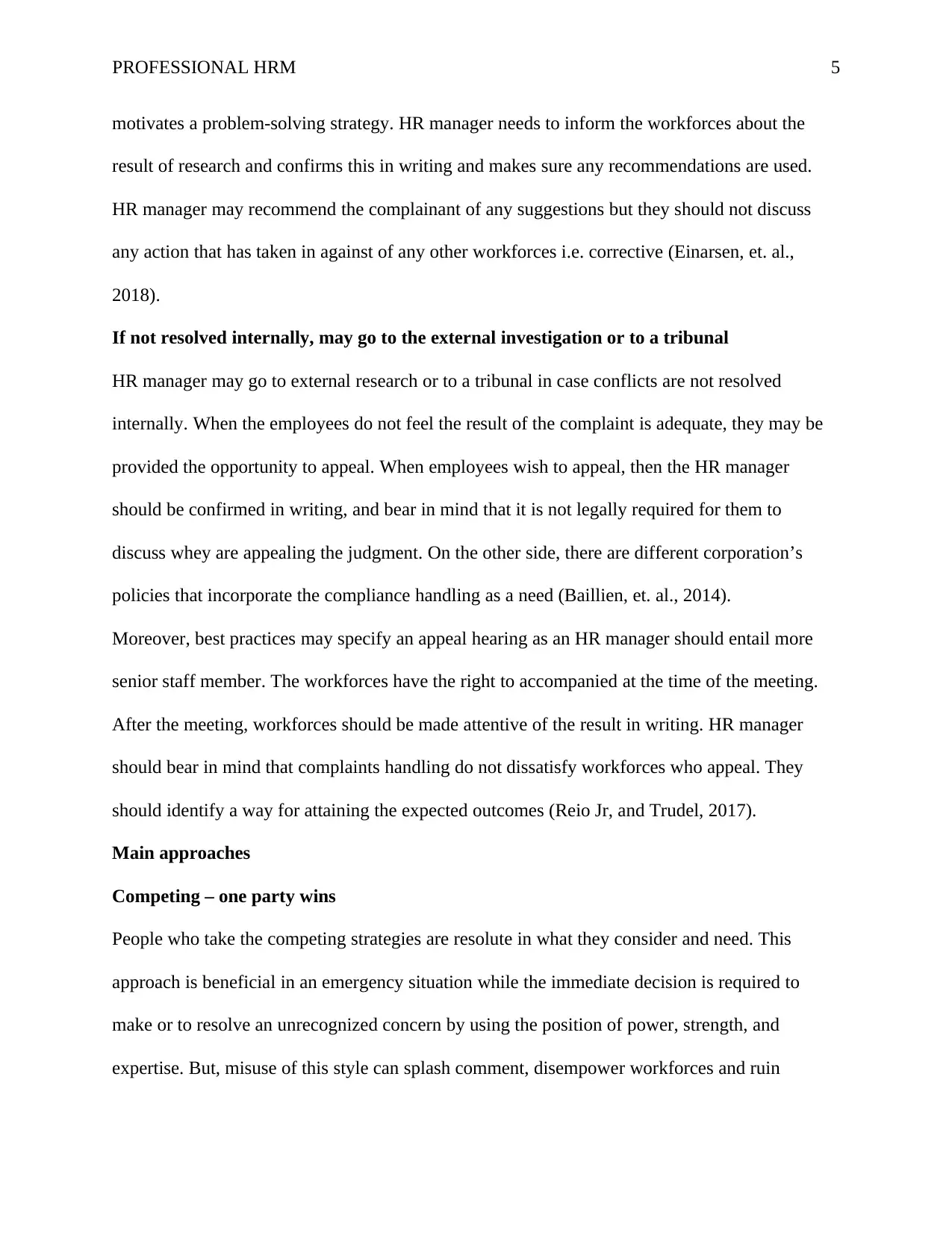
PROFESSIONAL HRM 5
motivates a problem-solving strategy. HR manager needs to inform the workforces about the
result of research and confirms this in writing and makes sure any recommendations are used.
HR manager may recommend the complainant of any suggestions but they should not discuss
any action that has taken in against of any other workforces i.e. corrective (Einarsen, et. al.,
2018).
If not resolved internally, may go to the external investigation or to a tribunal
HR manager may go to external research or to a tribunal in case conflicts are not resolved
internally. When the employees do not feel the result of the complaint is adequate, they may be
provided the opportunity to appeal. When employees wish to appeal, then the HR manager
should be confirmed in writing, and bear in mind that it is not legally required for them to
discuss whey are appealing the judgment. On the other side, there are different corporation’s
policies that incorporate the compliance handling as a need (Baillien, et. al., 2014).
Moreover, best practices may specify an appeal hearing as an HR manager should entail more
senior staff member. The workforces have the right to accompanied at the time of the meeting.
After the meeting, workforces should be made attentive of the result in writing. HR manager
should bear in mind that complaints handling do not dissatisfy workforces who appeal. They
should identify a way for attaining the expected outcomes (Reio Jr, and Trudel, 2017).
Main approaches
Competing – one party wins
People who take the competing strategies are resolute in what they consider and need. This
approach is beneficial in an emergency situation while the immediate decision is required to
make or to resolve an unrecognized concern by using the position of power, strength, and
expertise. But, misuse of this style can splash comment, disempower workforces and ruin
motivates a problem-solving strategy. HR manager needs to inform the workforces about the
result of research and confirms this in writing and makes sure any recommendations are used.
HR manager may recommend the complainant of any suggestions but they should not discuss
any action that has taken in against of any other workforces i.e. corrective (Einarsen, et. al.,
2018).
If not resolved internally, may go to the external investigation or to a tribunal
HR manager may go to external research or to a tribunal in case conflicts are not resolved
internally. When the employees do not feel the result of the complaint is adequate, they may be
provided the opportunity to appeal. When employees wish to appeal, then the HR manager
should be confirmed in writing, and bear in mind that it is not legally required for them to
discuss whey are appealing the judgment. On the other side, there are different corporation’s
policies that incorporate the compliance handling as a need (Baillien, et. al., 2014).
Moreover, best practices may specify an appeal hearing as an HR manager should entail more
senior staff member. The workforces have the right to accompanied at the time of the meeting.
After the meeting, workforces should be made attentive of the result in writing. HR manager
should bear in mind that complaints handling do not dissatisfy workforces who appeal. They
should identify a way for attaining the expected outcomes (Reio Jr, and Trudel, 2017).
Main approaches
Competing – one party wins
People who take the competing strategies are resolute in what they consider and need. This
approach is beneficial in an emergency situation while the immediate decision is required to
make or to resolve an unrecognized concern by using the position of power, strength, and
expertise. But, misuse of this style can splash comment, disempower workforces and ruin
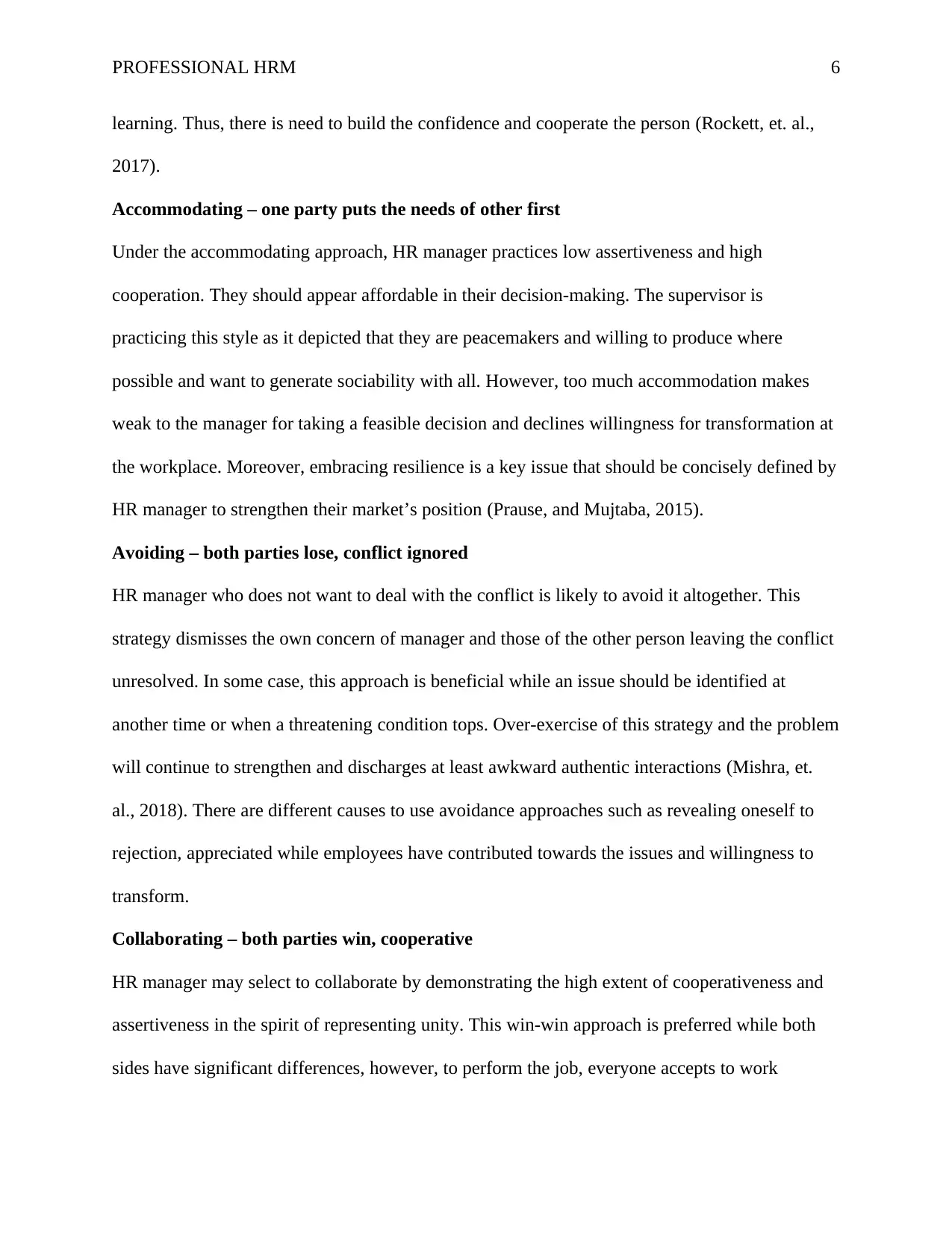
PROFESSIONAL HRM 6
learning. Thus, there is need to build the confidence and cooperate the person (Rockett, et. al.,
2017).
Accommodating – one party puts the needs of other first
Under the accommodating approach, HR manager practices low assertiveness and high
cooperation. They should appear affordable in their decision-making. The supervisor is
practicing this style as it depicted that they are peacemakers and willing to produce where
possible and want to generate sociability with all. However, too much accommodation makes
weak to the manager for taking a feasible decision and declines willingness for transformation at
the workplace. Moreover, embracing resilience is a key issue that should be concisely defined by
HR manager to strengthen their market’s position (Prause, and Mujtaba, 2015).
Avoiding – both parties lose, conflict ignored
HR manager who does not want to deal with the conflict is likely to avoid it altogether. This
strategy dismisses the own concern of manager and those of the other person leaving the conflict
unresolved. In some case, this approach is beneficial while an issue should be identified at
another time or when a threatening condition tops. Over-exercise of this strategy and the problem
will continue to strengthen and discharges at least awkward authentic interactions (Mishra, et.
al., 2018). There are different causes to use avoidance approaches such as revealing oneself to
rejection, appreciated while employees have contributed towards the issues and willingness to
transform.
Collaborating – both parties win, cooperative
HR manager may select to collaborate by demonstrating the high extent of cooperativeness and
assertiveness in the spirit of representing unity. This win-win approach is preferred while both
sides have significant differences, however, to perform the job, everyone accepts to work
learning. Thus, there is need to build the confidence and cooperate the person (Rockett, et. al.,
2017).
Accommodating – one party puts the needs of other first
Under the accommodating approach, HR manager practices low assertiveness and high
cooperation. They should appear affordable in their decision-making. The supervisor is
practicing this style as it depicted that they are peacemakers and willing to produce where
possible and want to generate sociability with all. However, too much accommodation makes
weak to the manager for taking a feasible decision and declines willingness for transformation at
the workplace. Moreover, embracing resilience is a key issue that should be concisely defined by
HR manager to strengthen their market’s position (Prause, and Mujtaba, 2015).
Avoiding – both parties lose, conflict ignored
HR manager who does not want to deal with the conflict is likely to avoid it altogether. This
strategy dismisses the own concern of manager and those of the other person leaving the conflict
unresolved. In some case, this approach is beneficial while an issue should be identified at
another time or when a threatening condition tops. Over-exercise of this strategy and the problem
will continue to strengthen and discharges at least awkward authentic interactions (Mishra, et.
al., 2018). There are different causes to use avoidance approaches such as revealing oneself to
rejection, appreciated while employees have contributed towards the issues and willingness to
transform.
Collaborating – both parties win, cooperative
HR manager may select to collaborate by demonstrating the high extent of cooperativeness and
assertiveness in the spirit of representing unity. This win-win approach is preferred while both
sides have significant differences, however, to perform the job, everyone accepts to work
⊘ This is a preview!⊘
Do you want full access?
Subscribe today to unlock all pages.

Trusted by 1+ million students worldwide
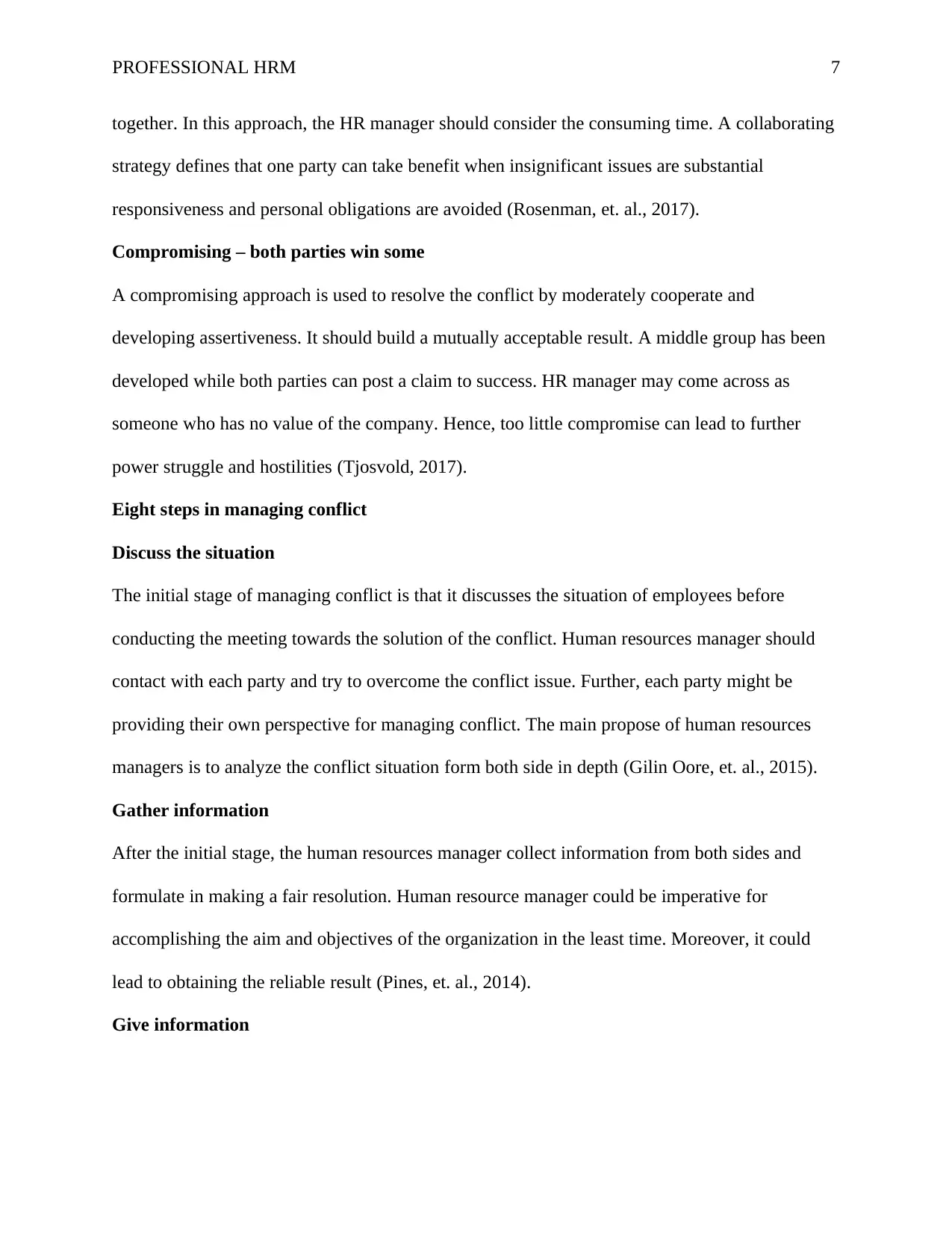
PROFESSIONAL HRM 7
together. In this approach, the HR manager should consider the consuming time. A collaborating
strategy defines that one party can take benefit when insignificant issues are substantial
responsiveness and personal obligations are avoided (Rosenman, et. al., 2017).
Compromising – both parties win some
A compromising approach is used to resolve the conflict by moderately cooperate and
developing assertiveness. It should build a mutually acceptable result. A middle group has been
developed while both parties can post a claim to success. HR manager may come across as
someone who has no value of the company. Hence, too little compromise can lead to further
power struggle and hostilities (Tjosvold, 2017).
Eight steps in managing conflict
Discuss the situation
The initial stage of managing conflict is that it discusses the situation of employees before
conducting the meeting towards the solution of the conflict. Human resources manager should
contact with each party and try to overcome the conflict issue. Further, each party might be
providing their own perspective for managing conflict. The main propose of human resources
managers is to analyze the conflict situation form both side in depth (Gilin Oore, et. al., 2015).
Gather information
After the initial stage, the human resources manager collect information from both sides and
formulate in making a fair resolution. Human resource manager could be imperative for
accomplishing the aim and objectives of the organization in the least time. Moreover, it could
lead to obtaining the reliable result (Pines, et. al., 2014).
Give information
together. In this approach, the HR manager should consider the consuming time. A collaborating
strategy defines that one party can take benefit when insignificant issues are substantial
responsiveness and personal obligations are avoided (Rosenman, et. al., 2017).
Compromising – both parties win some
A compromising approach is used to resolve the conflict by moderately cooperate and
developing assertiveness. It should build a mutually acceptable result. A middle group has been
developed while both parties can post a claim to success. HR manager may come across as
someone who has no value of the company. Hence, too little compromise can lead to further
power struggle and hostilities (Tjosvold, 2017).
Eight steps in managing conflict
Discuss the situation
The initial stage of managing conflict is that it discusses the situation of employees before
conducting the meeting towards the solution of the conflict. Human resources manager should
contact with each party and try to overcome the conflict issue. Further, each party might be
providing their own perspective for managing conflict. The main propose of human resources
managers is to analyze the conflict situation form both side in depth (Gilin Oore, et. al., 2015).
Gather information
After the initial stage, the human resources manager collect information from both sides and
formulate in making a fair resolution. Human resource manager could be imperative for
accomplishing the aim and objectives of the organization in the least time. Moreover, it could
lead to obtaining the reliable result (Pines, et. al., 2014).
Give information
Paraphrase This Document
Need a fresh take? Get an instant paraphrase of this document with our AI Paraphraser
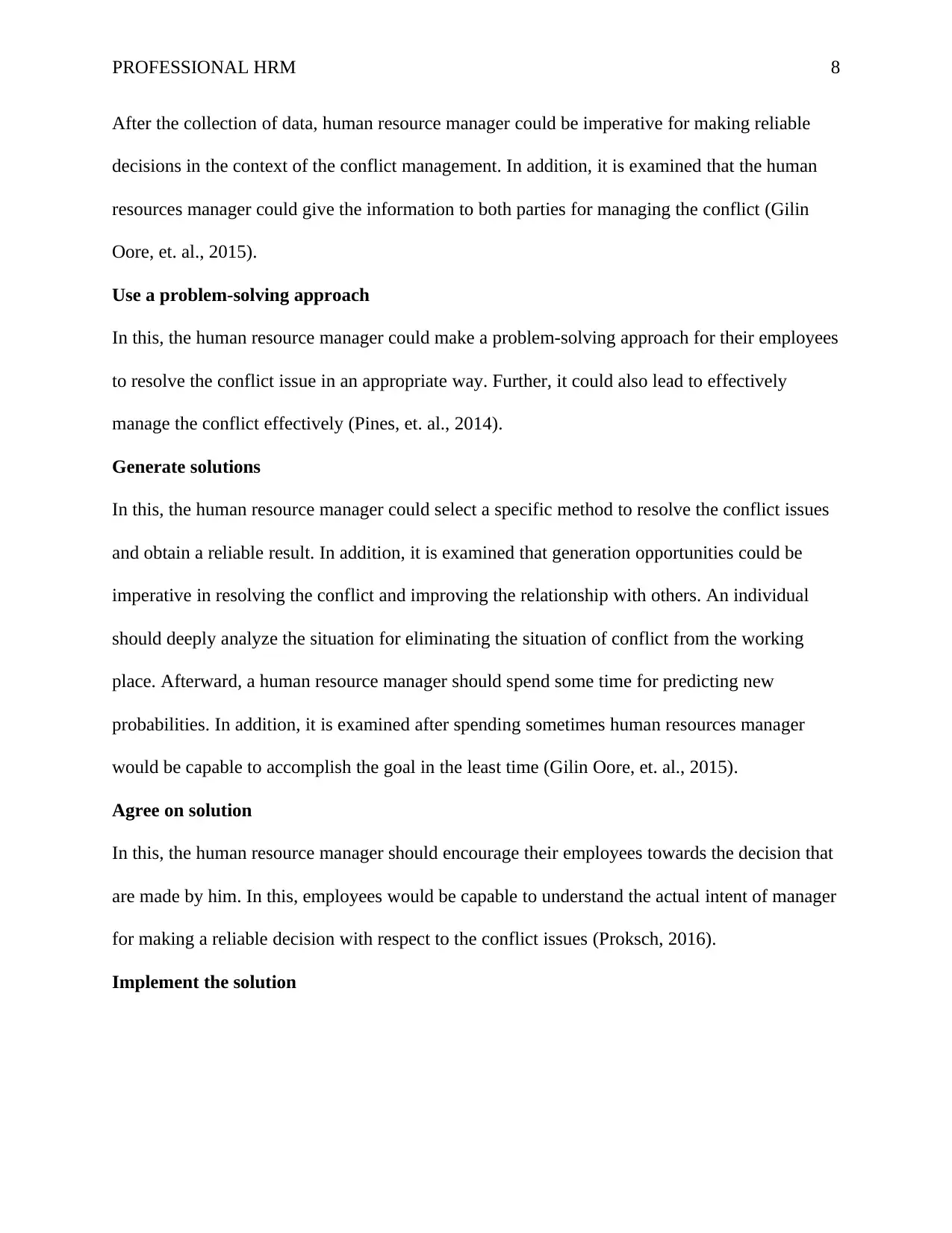
PROFESSIONAL HRM 8
After the collection of data, human resource manager could be imperative for making reliable
decisions in the context of the conflict management. In addition, it is examined that the human
resources manager could give the information to both parties for managing the conflict (Gilin
Oore, et. al., 2015).
Use a problem-solving approach
In this, the human resource manager could make a problem-solving approach for their employees
to resolve the conflict issue in an appropriate way. Further, it could also lead to effectively
manage the conflict effectively (Pines, et. al., 2014).
Generate solutions
In this, the human resource manager could select a specific method to resolve the conflict issues
and obtain a reliable result. In addition, it is examined that generation opportunities could be
imperative in resolving the conflict and improving the relationship with others. An individual
should deeply analyze the situation for eliminating the situation of conflict from the working
place. Afterward, a human resource manager should spend some time for predicting new
probabilities. In addition, it is examined after spending sometimes human resources manager
would be capable to accomplish the goal in the least time (Gilin Oore, et. al., 2015).
Agree on solution
In this, the human resource manager should encourage their employees towards the decision that
are made by him. In this, employees would be capable to understand the actual intent of manager
for making a reliable decision with respect to the conflict issues (Proksch, 2016).
Implement the solution
After the collection of data, human resource manager could be imperative for making reliable
decisions in the context of the conflict management. In addition, it is examined that the human
resources manager could give the information to both parties for managing the conflict (Gilin
Oore, et. al., 2015).
Use a problem-solving approach
In this, the human resource manager could make a problem-solving approach for their employees
to resolve the conflict issue in an appropriate way. Further, it could also lead to effectively
manage the conflict effectively (Pines, et. al., 2014).
Generate solutions
In this, the human resource manager could select a specific method to resolve the conflict issues
and obtain a reliable result. In addition, it is examined that generation opportunities could be
imperative in resolving the conflict and improving the relationship with others. An individual
should deeply analyze the situation for eliminating the situation of conflict from the working
place. Afterward, a human resource manager should spend some time for predicting new
probabilities. In addition, it is examined after spending sometimes human resources manager
would be capable to accomplish the goal in the least time (Gilin Oore, et. al., 2015).
Agree on solution
In this, the human resource manager should encourage their employees towards the decision that
are made by him. In this, employees would be capable to understand the actual intent of manager
for making a reliable decision with respect to the conflict issues (Proksch, 2016).
Implement the solution
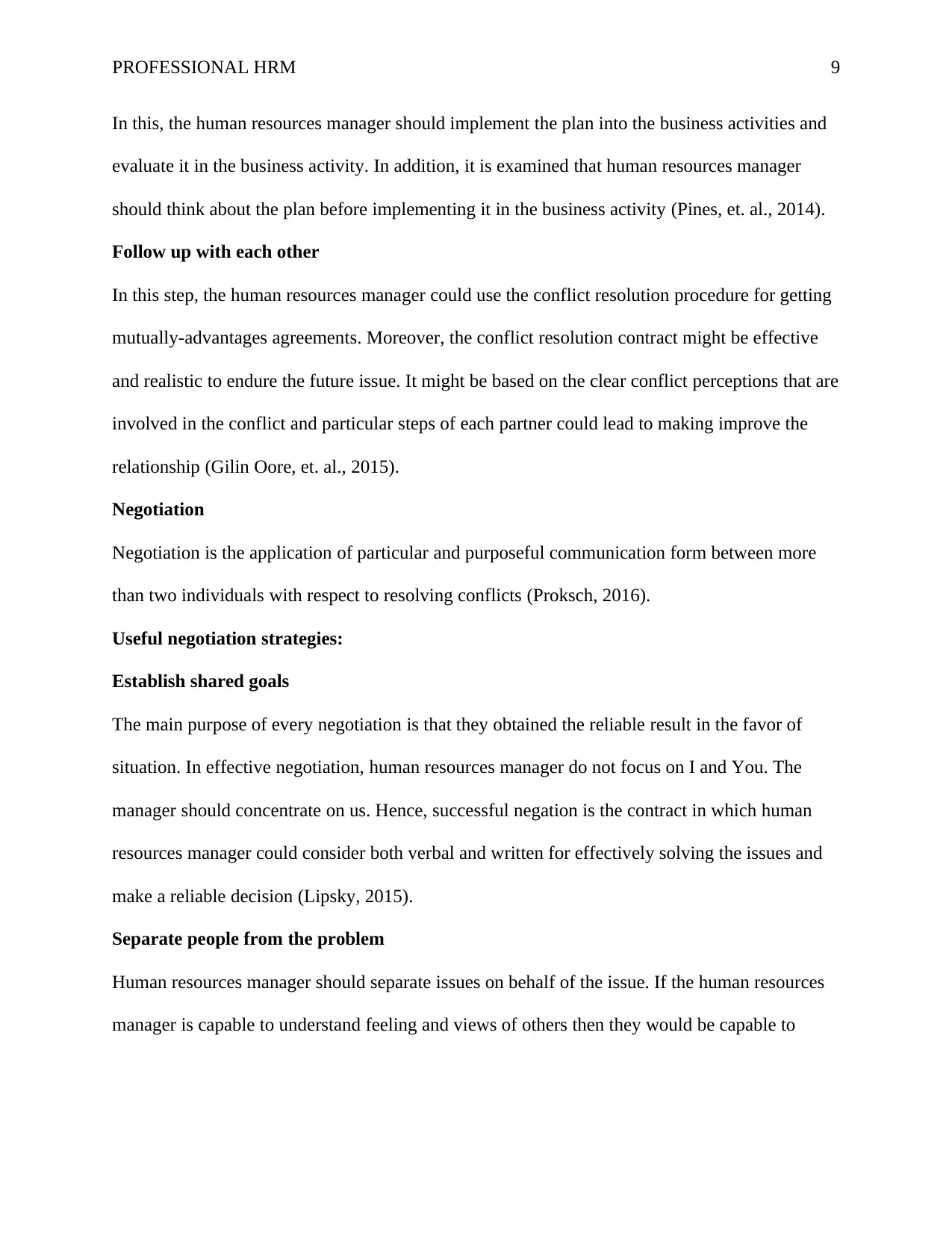
PROFESSIONAL HRM 9
In this, the human resources manager should implement the plan into the business activities and
evaluate it in the business activity. In addition, it is examined that human resources manager
should think about the plan before implementing it in the business activity (Pines, et. al., 2014).
Follow up with each other
In this step, the human resources manager could use the conflict resolution procedure for getting
mutually-advantages agreements. Moreover, the conflict resolution contract might be effective
and realistic to endure the future issue. It might be based on the clear conflict perceptions that are
involved in the conflict and particular steps of each partner could lead to making improve the
relationship (Gilin Oore, et. al., 2015).
Negotiation
Negotiation is the application of particular and purposeful communication form between more
than two individuals with respect to resolving conflicts (Proksch, 2016).
Useful negotiation strategies:
Establish shared goals
The main purpose of every negotiation is that they obtained the reliable result in the favor of
situation. In effective negotiation, human resources manager do not focus on I and You. The
manager should concentrate on us. Hence, successful negation is the contract in which human
resources manager could consider both verbal and written for effectively solving the issues and
make a reliable decision (Lipsky, 2015).
Separate people from the problem
Human resources manager should separate issues on behalf of the issue. If the human resources
manager is capable to understand feeling and views of others then they would be capable to
In this, the human resources manager should implement the plan into the business activities and
evaluate it in the business activity. In addition, it is examined that human resources manager
should think about the plan before implementing it in the business activity (Pines, et. al., 2014).
Follow up with each other
In this step, the human resources manager could use the conflict resolution procedure for getting
mutually-advantages agreements. Moreover, the conflict resolution contract might be effective
and realistic to endure the future issue. It might be based on the clear conflict perceptions that are
involved in the conflict and particular steps of each partner could lead to making improve the
relationship (Gilin Oore, et. al., 2015).
Negotiation
Negotiation is the application of particular and purposeful communication form between more
than two individuals with respect to resolving conflicts (Proksch, 2016).
Useful negotiation strategies:
Establish shared goals
The main purpose of every negotiation is that they obtained the reliable result in the favor of
situation. In effective negotiation, human resources manager do not focus on I and You. The
manager should concentrate on us. Hence, successful negation is the contract in which human
resources manager could consider both verbal and written for effectively solving the issues and
make a reliable decision (Lipsky, 2015).
Separate people from the problem
Human resources manager should separate issues on behalf of the issue. If the human resources
manager is capable to understand feeling and views of others then they would be capable to
⊘ This is a preview!⊘
Do you want full access?
Subscribe today to unlock all pages.

Trusted by 1+ million students worldwide
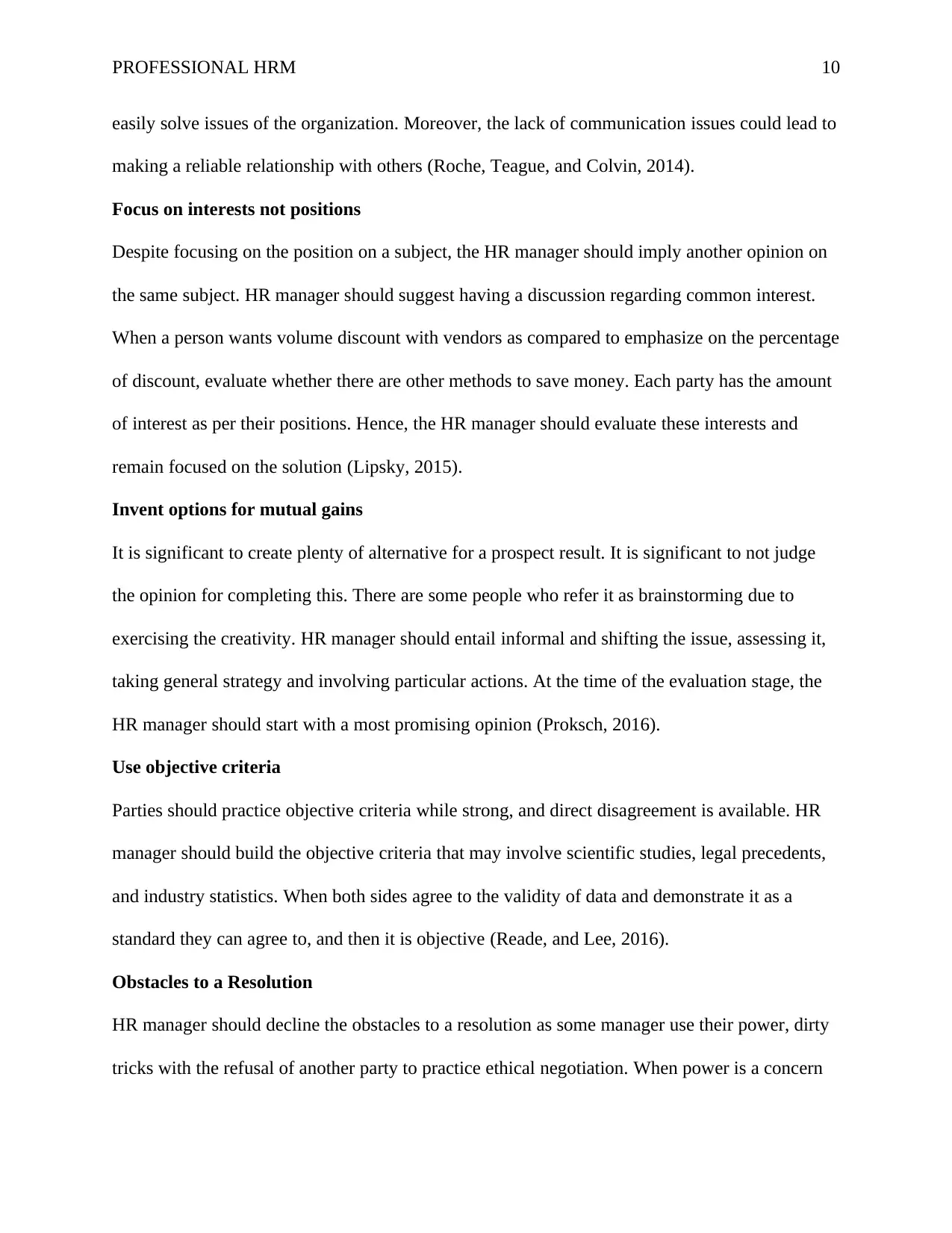
PROFESSIONAL HRM 10
easily solve issues of the organization. Moreover, the lack of communication issues could lead to
making a reliable relationship with others (Roche, Teague, and Colvin, 2014).
Focus on interests not positions
Despite focusing on the position on a subject, the HR manager should imply another opinion on
the same subject. HR manager should suggest having a discussion regarding common interest.
When a person wants volume discount with vendors as compared to emphasize on the percentage
of discount, evaluate whether there are other methods to save money. Each party has the amount
of interest as per their positions. Hence, the HR manager should evaluate these interests and
remain focused on the solution (Lipsky, 2015).
Invent options for mutual gains
It is significant to create plenty of alternative for a prospect result. It is significant to not judge
the opinion for completing this. There are some people who refer it as brainstorming due to
exercising the creativity. HR manager should entail informal and shifting the issue, assessing it,
taking general strategy and involving particular actions. At the time of the evaluation stage, the
HR manager should start with a most promising opinion (Proksch, 2016).
Use objective criteria
Parties should practice objective criteria while strong, and direct disagreement is available. HR
manager should build the objective criteria that may involve scientific studies, legal precedents,
and industry statistics. When both sides agree to the validity of data and demonstrate it as a
standard they can agree to, and then it is objective (Reade, and Lee, 2016).
Obstacles to a Resolution
HR manager should decline the obstacles to a resolution as some manager use their power, dirty
tricks with the refusal of another party to practice ethical negotiation. When power is a concern
easily solve issues of the organization. Moreover, the lack of communication issues could lead to
making a reliable relationship with others (Roche, Teague, and Colvin, 2014).
Focus on interests not positions
Despite focusing on the position on a subject, the HR manager should imply another opinion on
the same subject. HR manager should suggest having a discussion regarding common interest.
When a person wants volume discount with vendors as compared to emphasize on the percentage
of discount, evaluate whether there are other methods to save money. Each party has the amount
of interest as per their positions. Hence, the HR manager should evaluate these interests and
remain focused on the solution (Lipsky, 2015).
Invent options for mutual gains
It is significant to create plenty of alternative for a prospect result. It is significant to not judge
the opinion for completing this. There are some people who refer it as brainstorming due to
exercising the creativity. HR manager should entail informal and shifting the issue, assessing it,
taking general strategy and involving particular actions. At the time of the evaluation stage, the
HR manager should start with a most promising opinion (Proksch, 2016).
Use objective criteria
Parties should practice objective criteria while strong, and direct disagreement is available. HR
manager should build the objective criteria that may involve scientific studies, legal precedents,
and industry statistics. When both sides agree to the validity of data and demonstrate it as a
standard they can agree to, and then it is objective (Reade, and Lee, 2016).
Obstacles to a Resolution
HR manager should decline the obstacles to a resolution as some manager use their power, dirty
tricks with the refusal of another party to practice ethical negotiation. When power is a concern
Paraphrase This Document
Need a fresh take? Get an instant paraphrase of this document with our AI Paraphraser
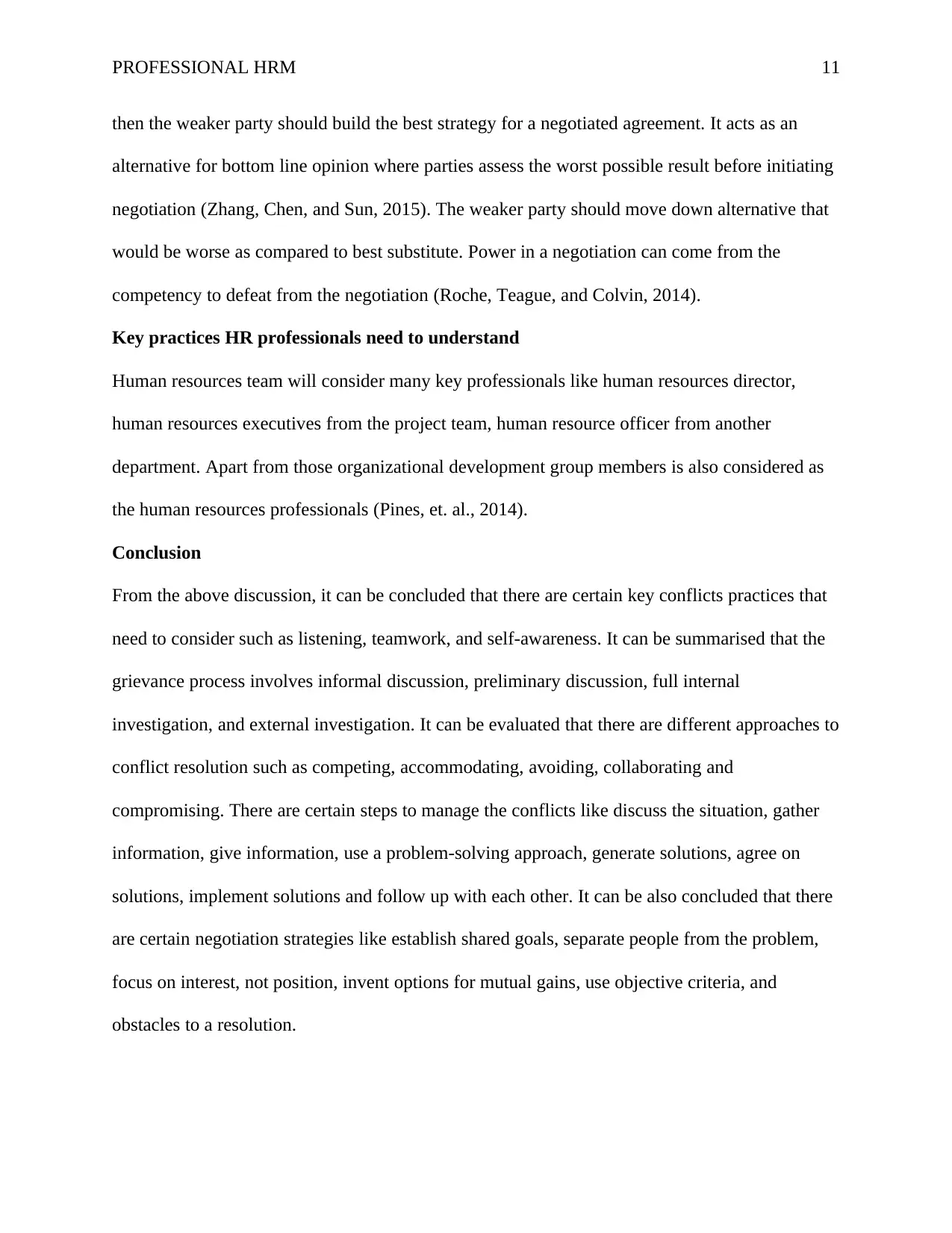
PROFESSIONAL HRM 11
then the weaker party should build the best strategy for a negotiated agreement. It acts as an
alternative for bottom line opinion where parties assess the worst possible result before initiating
negotiation (Zhang, Chen, and Sun, 2015). The weaker party should move down alternative that
would be worse as compared to best substitute. Power in a negotiation can come from the
competency to defeat from the negotiation (Roche, Teague, and Colvin, 2014).
Key practices HR professionals need to understand
Human resources team will consider many key professionals like human resources director,
human resources executives from the project team, human resource officer from another
department. Apart from those organizational development group members is also considered as
the human resources professionals (Pines, et. al., 2014).
Conclusion
From the above discussion, it can be concluded that there are certain key conflicts practices that
need to consider such as listening, teamwork, and self-awareness. It can be summarised that the
grievance process involves informal discussion, preliminary discussion, full internal
investigation, and external investigation. It can be evaluated that there are different approaches to
conflict resolution such as competing, accommodating, avoiding, collaborating and
compromising. There are certain steps to manage the conflicts like discuss the situation, gather
information, give information, use a problem-solving approach, generate solutions, agree on
solutions, implement solutions and follow up with each other. It can be also concluded that there
are certain negotiation strategies like establish shared goals, separate people from the problem,
focus on interest, not position, invent options for mutual gains, use objective criteria, and
obstacles to a resolution.
then the weaker party should build the best strategy for a negotiated agreement. It acts as an
alternative for bottom line opinion where parties assess the worst possible result before initiating
negotiation (Zhang, Chen, and Sun, 2015). The weaker party should move down alternative that
would be worse as compared to best substitute. Power in a negotiation can come from the
competency to defeat from the negotiation (Roche, Teague, and Colvin, 2014).
Key practices HR professionals need to understand
Human resources team will consider many key professionals like human resources director,
human resources executives from the project team, human resource officer from another
department. Apart from those organizational development group members is also considered as
the human resources professionals (Pines, et. al., 2014).
Conclusion
From the above discussion, it can be concluded that there are certain key conflicts practices that
need to consider such as listening, teamwork, and self-awareness. It can be summarised that the
grievance process involves informal discussion, preliminary discussion, full internal
investigation, and external investigation. It can be evaluated that there are different approaches to
conflict resolution such as competing, accommodating, avoiding, collaborating and
compromising. There are certain steps to manage the conflicts like discuss the situation, gather
information, give information, use a problem-solving approach, generate solutions, agree on
solutions, implement solutions and follow up with each other. It can be also concluded that there
are certain negotiation strategies like establish shared goals, separate people from the problem,
focus on interest, not position, invent options for mutual gains, use objective criteria, and
obstacles to a resolution.
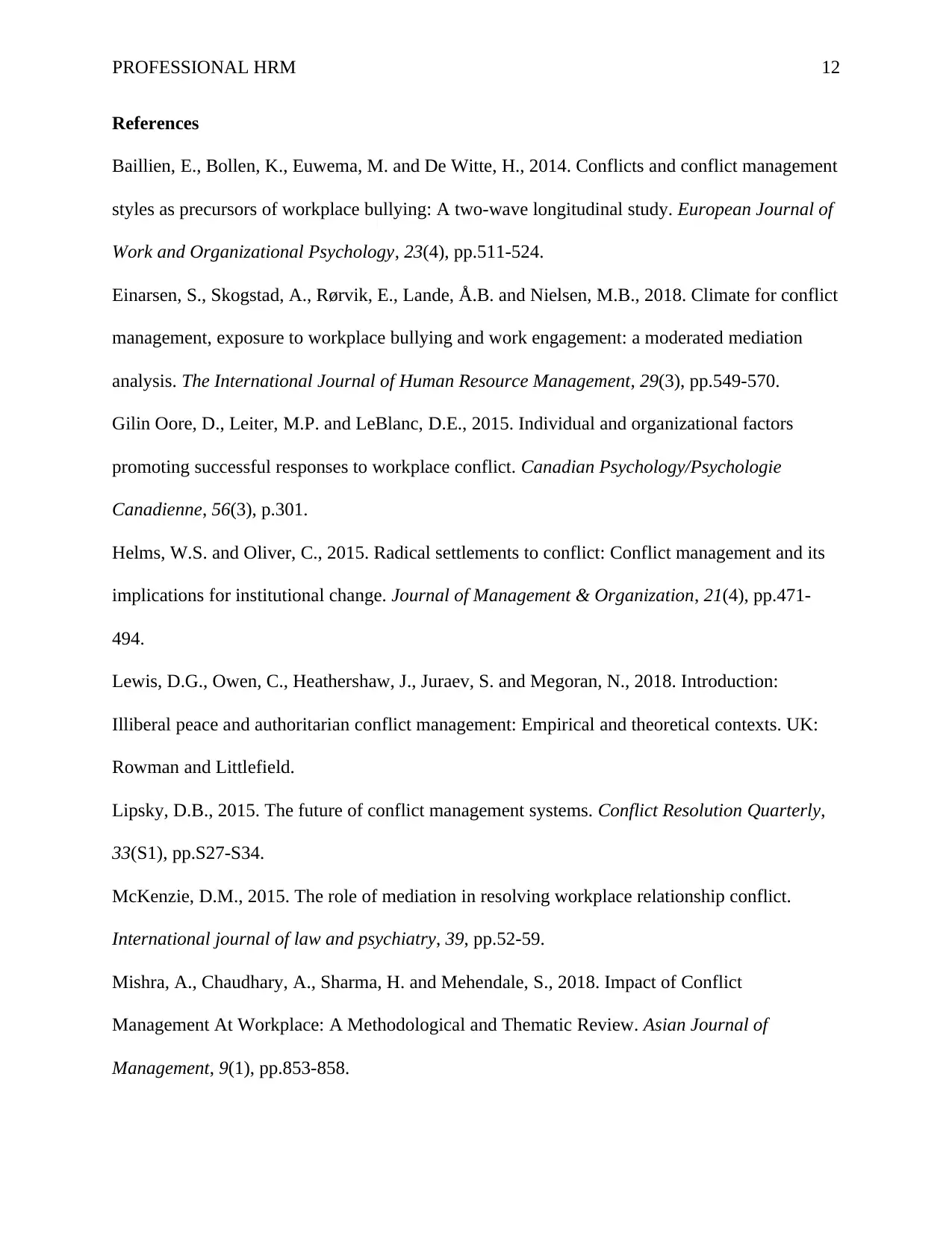
PROFESSIONAL HRM 12
References
Baillien, E., Bollen, K., Euwema, M. and De Witte, H., 2014. Conflicts and conflict management
styles as precursors of workplace bullying: A two-wave longitudinal study. European Journal of
Work and Organizational Psychology, 23(4), pp.511-524.
Einarsen, S., Skogstad, A., Rørvik, E., Lande, Å.B. and Nielsen, M.B., 2018. Climate for conflict
management, exposure to workplace bullying and work engagement: a moderated mediation
analysis. The International Journal of Human Resource Management, 29(3), pp.549-570.
Gilin Oore, D., Leiter, M.P. and LeBlanc, D.E., 2015. Individual and organizational factors
promoting successful responses to workplace conflict. Canadian Psychology/Psychologie
Canadienne, 56(3), p.301.
Helms, W.S. and Oliver, C., 2015. Radical settlements to conflict: Conflict management and its
implications for institutional change. Journal of Management & Organization, 21(4), pp.471-
494.
Lewis, D.G., Owen, C., Heathershaw, J., Juraev, S. and Megoran, N., 2018. Introduction:
Illiberal peace and authoritarian conflict management: Empirical and theoretical contexts. UK:
Rowman and Littlefield.
Lipsky, D.B., 2015. The future of conflict management systems. Conflict Resolution Quarterly,
33(S1), pp.S27-S34.
McKenzie, D.M., 2015. The role of mediation in resolving workplace relationship conflict.
International journal of law and psychiatry, 39, pp.52-59.
Mishra, A., Chaudhary, A., Sharma, H. and Mehendale, S., 2018. Impact of Conflict
Management At Workplace: A Methodological and Thematic Review. Asian Journal of
Management, 9(1), pp.853-858.
References
Baillien, E., Bollen, K., Euwema, M. and De Witte, H., 2014. Conflicts and conflict management
styles as precursors of workplace bullying: A two-wave longitudinal study. European Journal of
Work and Organizational Psychology, 23(4), pp.511-524.
Einarsen, S., Skogstad, A., Rørvik, E., Lande, Å.B. and Nielsen, M.B., 2018. Climate for conflict
management, exposure to workplace bullying and work engagement: a moderated mediation
analysis. The International Journal of Human Resource Management, 29(3), pp.549-570.
Gilin Oore, D., Leiter, M.P. and LeBlanc, D.E., 2015. Individual and organizational factors
promoting successful responses to workplace conflict. Canadian Psychology/Psychologie
Canadienne, 56(3), p.301.
Helms, W.S. and Oliver, C., 2015. Radical settlements to conflict: Conflict management and its
implications for institutional change. Journal of Management & Organization, 21(4), pp.471-
494.
Lewis, D.G., Owen, C., Heathershaw, J., Juraev, S. and Megoran, N., 2018. Introduction:
Illiberal peace and authoritarian conflict management: Empirical and theoretical contexts. UK:
Rowman and Littlefield.
Lipsky, D.B., 2015. The future of conflict management systems. Conflict Resolution Quarterly,
33(S1), pp.S27-S34.
McKenzie, D.M., 2015. The role of mediation in resolving workplace relationship conflict.
International journal of law and psychiatry, 39, pp.52-59.
Mishra, A., Chaudhary, A., Sharma, H. and Mehendale, S., 2018. Impact of Conflict
Management At Workplace: A Methodological and Thematic Review. Asian Journal of
Management, 9(1), pp.853-858.
⊘ This is a preview!⊘
Do you want full access?
Subscribe today to unlock all pages.

Trusted by 1+ million students worldwide
1 out of 14
Related Documents
Your All-in-One AI-Powered Toolkit for Academic Success.
+13062052269
info@desklib.com
Available 24*7 on WhatsApp / Email
![[object Object]](/_next/static/media/star-bottom.7253800d.svg)
Unlock your academic potential
Copyright © 2020–2025 A2Z Services. All Rights Reserved. Developed and managed by ZUCOL.




